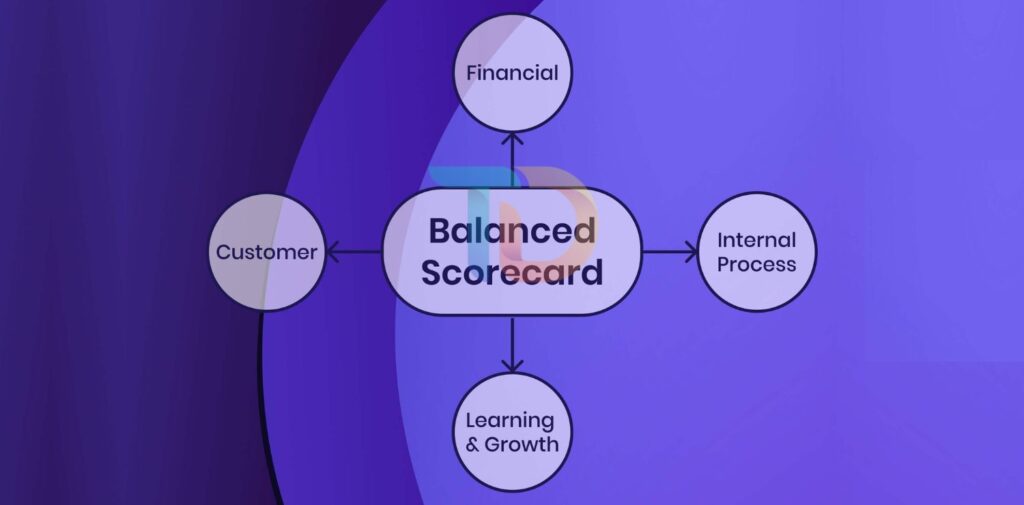In today’s fast-paced business environment, especially in India, companies need an effective tool to measure and manage their strategies. The Balanced Scorecard (BSC) is one such powerful tool that helps businesses align their operations with their vision and strategy. This approach goes beyond just financial metrics, considering four key perspectives to evaluate a company’s performance. In this article, we will explore what the Balanced Scorecard is, how it works, and how businesses can use it for effective strategic management.
What is the Balanced Scorecard?
The Balanced Scorecard is a strategic management tool developed by Robert Kaplan and David Norton in the 1990s. It helps organizations measure their performance from four perspectives: financial, customer, internal processes, and learning and growth. This approach ensures that businesses do not focus solely on financial results but also consider customer satisfaction, internal efficiency, and employee development.
In India, where businesses are often focused on growth, innovation, and profitability, using the Balanced Scorecard can help leaders maintain a balanced approach to strategy. It allows them to track a company’s overall health and make decisions based on a well-rounded view of performance.

Four Key Perspectives of the Balanced Scorecard
- Financial Perspective: This is the traditional measure of a company’s performance, focusing on financial outcomes such as profitability, revenue growth, and cost management. For Indian businesses, this perspective is crucial because financial success is a primary goal. However, the Balanced Scorecard emphasizes that financial results should not be the only focus.
- Customer Perspective: This perspective evaluates how well the company is serving its customers and meeting their needs. Key metrics may include customer satisfaction, loyalty, and market share. In India, where the customer base is diverse, understanding what different customer segments want can help businesses tailor their products or services to meet those demands effectively.
- Internal Processes Perspective: This focuses on the internal efficiency of the business. It evaluates the processes that create value for customers and shareholders. By improving internal processes, businesses can ensure they deliver high-quality products and services efficiently. In India, where competition is fierce, improving internal operations can help businesses gain a competitive edge.
- Learning and Growth Perspective: This perspective is about employee development, innovation, and organizational culture. It highlights the importance of continuous learning and the development of skills and capabilities within the organization. In India, where a young and dynamic workforce is key, investing in employee training and growth ensures the business remains adaptable and innovative.
How to Implement the Balanced Scorecard for Strategic Management
- Define Clear Strategic Goals: The first step in using the Balanced Scorecard is to define your business’s strategic goals. This could involve growth objectives, customer satisfaction goals, process improvements, or employee development. In India’s competitive market, it’s important to set clear, measurable goals that align with both long-term and short-term business objectives.
- Identify Key Performance Indicators (KPIs): For each of the four perspectives, you need to identify specific Key Performance Indicators (KPIs). These are the measurable metrics that help track progress toward achieving strategic goals. For example, in the customer perspective, KPIs could include customer satisfaction scores or net promoter scores (NPS). For internal processes, it could be metrics like production efficiency or delivery times.
- Create an Action Plan: Once the KPIs are in place, businesses need to develop an action plan to achieve their strategic goals. The action plan should detail the specific steps, resources, and timelines required to meet the targets set for each perspective. In India, where market conditions and customer expectations change rapidly, a flexible action plan is crucial.
- Monitor and Adjust Regularly: One of the key advantages of the Balanced Scorecard is its ability to provide ongoing feedback. Regular monitoring of the KPIs allows businesses to track progress and identify areas for improvement. If certain strategies are not yielding the desired results, adjustments can be made to stay on track. In India’s fast-moving markets, businesses must be ready to adapt quickly to changing circumstances.

Benefits of Using the Balanced Scorecard
- Holistic View of Performance: The Balanced Scorecard allows businesses to look beyond financial results and assess their performance from multiple angles. This holistic view ensures that companies in India, or anywhere else, are not just focused on short-term financial gains but also on long-term success.
- Alignment of Business Activities: By using the Balanced Scorecard, businesses can ensure that their day-to-day activities are aligned with their broader strategic goals. This helps create a more cohesive and coordinated approach to strategy.
- Improved Decision-Making: The Balanced Scorecard provides managers with relevant data and insights, helping them make informed decisions. With a clear picture of how the company is performing across different areas, decision-makers can prioritize initiatives that will drive the most value.
- Enhanced Accountability and Motivation: With clearly defined goals and KPIs, employees at all levels understand what is expected of them. This leads to better accountability and motivation as everyone works towards common strategic objectives.
Conclusion
In conclusion, the Balanced Scorecard is a valuable tool for businesses aiming to achieve long-term strategic success. It helps businesses in India and around the world track performance from four key perspectives: financial, customer, internal processes, and learning and growth. By implementing the Balanced Scorecard, businesses can ensure that their strategies are well-rounded, aligned with their goals, and flexible enough to adapt to changing conditions. With its ability to provide comprehensive insights into business performance, the Balanced Scorecard is an essential tool for effective strategic management.


